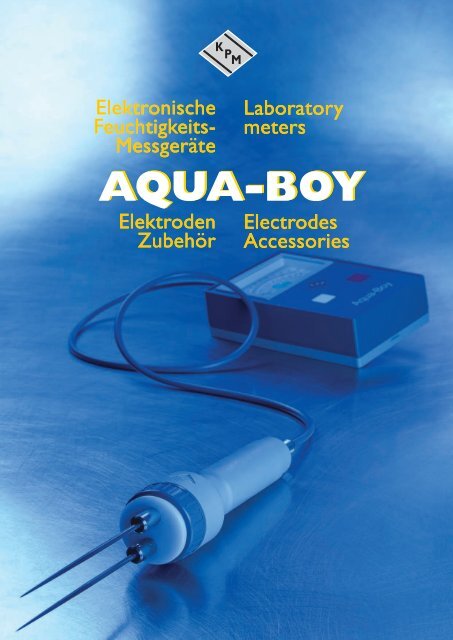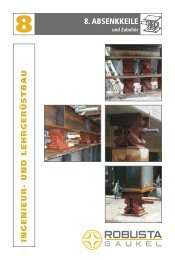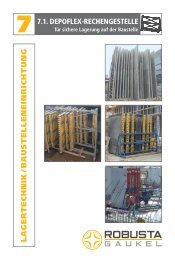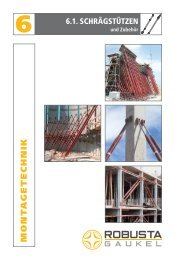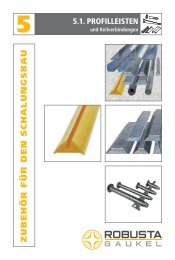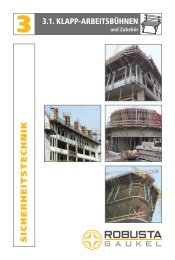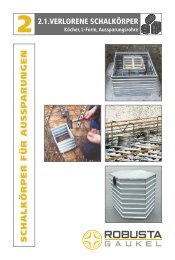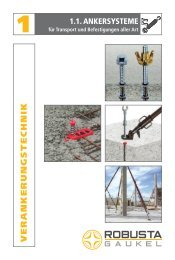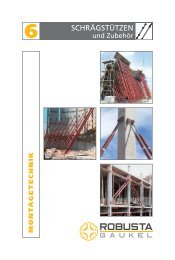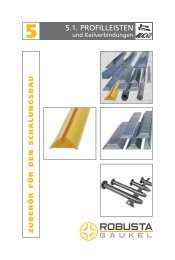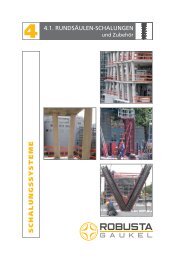Sie wollen auch ein ePaper? Erhöhen Sie die Reichweite Ihrer Titel.
YUMPU macht aus Druck-PDFs automatisch weboptimierte ePaper, die Google liebt.
AQUA-BOY
AQUA-BOYKleines handliches Taschenformat.Direkt ablesbare Prozentskalen.Batteriebetrieb.AQUA-BOYSmal, compact pocket size.Percentage scales for direct readings.Battery operated.2
Für alle Betriebe der Holzwirtschaft, obim Einkauf, im Handel oder in der Lagerhaltung,aber hauptsächlich in der Fabrikation,ist eine dauernde Kontrolle desHolzes auf seinen Feuchtigkeitsgehaltunerlässlich, damit ein qualitativ hochwertigesEndprodukt sichergestellt ist.Das Holz hat bekanntlich neben seinensehr guten Eigenschaften auch die wenigerangenehme Eigenschaft, sehr hygroskopischzu sein. Darum ist das Holzdauernd bestrebt, einen Ausgleichzwischen der Eigenfeuchtigkeit und derrelativen Luftfeuchtigkeit zu schaffen unddadurch ständigen Feuchtigkeitsschwankungenunterworfen. Diese Feuchtigkeitsschwankungenwirken sich so aus, dass beiAnsteigen der relativen Luftfeuchtigkeiteine Feuchtigkeitszunahme und bei Absinkender relativen Luftfeuchtigkeit eineFeuchtigkeitsabnahme im Holz stattfindet.Wird das Holz nach der Trocknung biszur Weiterverarbeitung gelagert oderklimatisiert, so sollten auch diese Maßnahmendurch Feuchtigkeitskontrollenüberwacht werden, um die gewünschteHolzfeuchtigkeit in den notwendigenGrenzen zu halten. Dabei ergibt sich vorteilhafteine zusätzliche Überprüfung derBrauchbarkeit des Lagerraumes. Durchdie laufenden Feuchtigkeitskontrollenwird gleichzeitig festgestellt, welche Lagerstellenim Vorrats- oder Klimaraumwegen Zugluft, Luftstauungen oderfeuchten Bodenstellen ungeeignet sind.Bei der Auswahl des Holzes zurVerarbeitung sind Feuchtigkeitsprüfungennotwendig, um absolut sicher zusein, dass nur solche Hölzer verwendetwerden, bei denen der FeuchtigkeitsgehaltdemVerwendungszweck angepasst ist.Bei der Verleimung von Hölzern, z.B.bei Holzkonstruktionen, wie auch bei derFurnierung oder Verleimung von SperroderSpanplatten ist es außerordentlichwichtig, den richtigen Feuchtigkeitsgehalteinzuhalten, um eine maximale Haftfestigkeitder verleimten Teile zu erzielen.Das Holz soll dem jeweiligen Verwendungszweckentsprechend nach der Verarbeitungschon den Feuchtigkeitsgehalthaben, den es später im Gebrauchszustanddurch die umgebende Luftfeuchtigkeitbedingt annehmen wird.können folgende Richtwerte fürHolzfeuchtigkeit angegeben werden:Furnierplatten, Sperrplatten, Schichtholzca. 5 – 7%Zimmertüren und alle Hölzer innerhalbvon geschlossenen Wohnräumen mitZentralheizung ca. 6 – 9%Zimmertüren und alle Hölzer innerhalbvon geschlossenen Wohnräumen mitOfenheizung ca. 10 – 12%Fensterrahmen, Haustüren, Bauhölzer undalle Hölzer, die einseitig mit der Außenluftin Berührung kommen ca. 12 – 15%Alle im Freien zum Einsatz kommendenHölzer, wie z.B. Eisenbahnwagen, Transportkisten,Lastkraftwagen usw., sowieauch Holzböden in Klimaräumenca. 13 – 16%Bauhölzer ca. 15 – 20%In den DIN-Normen 4 074, 18 334,18 355, 18 356, 18 367, 52 351, 52 360-62,68 360, 68 365, 68 701, 68 705, 68 763sind alle Holz-Güte- und Überwachungsbedingungenenthalten.Werden keine Feuchtigskeitsmessungendurchgeführt, so hat dies oft zur Folge,dass Arbeiten, die handwerklich einwandfreiausgeführt werden, nach Fertigstellungin kurzer Zeit verdorben sind.Bei diesem Tatbestand lassen sichmeistens unliebsame und kostspieligeReklamationen nicht vermeiden.Um alle diese vielseitigen Messaufgabenerfolgreich und rationell durchführenzu können, ist die Verwendung eineselektrischen Feuchtigkeitsmessgeräteszu empfehlen.Speziell für solche Holzfeuchtigkeits-Prüfungen wurden elektronischeMessgeräte entwickelt. Die Messgerätehaben dem jeweiligen Verwendungszweckangepasste Mess-Skalen und sind inverschiedene Typen aufgeteilt.Es ist zweckmäßig, mit der Feuchtigkeitsüberwachungschon vor der künstlichenHolztrocknung zu beginnen. Bei dieserPrüfung können sehr stark in der Feuchtigkeitvoneinander abweichende Hölzeraussortiert und die Trockungseinrichtungenmit Hölzern von etwa gleicherAnfangsfeuchte beschickt werden.Dadurch lässt sich eine gleichmäßigereTrocknung aller Hölzer erzielen.Diese Überlegung gilt auch für FurnierundSpäne-Trockner, denn bei allenTrocknern ist eine wirtschaftliche Ausnutzungnur dann sichergestellt, wenn alleHölzer ohne Übertrocknung gleichmäßigden für die Weiterverarbeitung notwendigenEndfeuchtigkeitswert erreichen.Auch der Trocknungsablauf kann durchHolzfeuchtigkeitsmessungen genauerüberwacht und durch Feuchtigkeitsgefällemessungeneine beginnende Verschalungsofort erkannt werden.Wenn keine Feuchtigkeitsüberwachungstattfindet, wird vielfach aus übertriebenerVorsicht das Holz so stark ausgetrocknet,dass es für die Verarbeitungschon viel zu trocken ist und durch dieÜbertrocknung auch noch Festigkeitswertverlusteauftreten.3
Zur Oberflächen- und Tiefenmessung inSperrholz, Furnieren, Mittellagen, Holz-Faserplatten,Brettern, Bohlen, Kanthölzern,Parkettfriesen, Holzspänen, Sägemehl usw.vorzugsweise mit den ElektrodenNr. 203 a, b, c, d, So, 208, 209, 210, 213Messbereich: 5-28% Holzfeuchte567 89 1012 1416 18 20 22 24%Feuchtigkeit HumedadMoisture UmiditáHumidità28For surface and depth measurement inplywood, veneers, core layers, fibreboards,panels, planks, squared timber,parquet friezes, wood chip, sawdust etc.For use with electrodesNo. 203 a, b, c, d, So, 208, 209, 210, 213Measuring range:5-28% wood moisture contentZur Messung über dem Fasersättigungspunkt,speziell für waldfrische Hölzer undzur Trocknungsauswahl, vorzugsweise mitden Elektroden Nr. 203 a, So(Elektroden quer zur Faserrichtungeinschlagen)Messbereich: 30-120% Holzfeuchte30405060 7080 90 100 110%Feuchtigkeit HumedadMoisture UmiditáHumidità120For measuring above the fibre saturationpoint, especially for newly harvestedtimbers and selecting drying type, useelectrode No. 203 a, So(Insert electrodes across the grain)Measuring range:30-120% wood moisture contentZur Messung vor und nach der Trocknung,sowie zur Kontrolle bei der Weiterverarbeitung,vorzugsweise mit denElektrodenNr. 203 a, b, c, d, So, 208, 209, 210, 213Messbereich 6-60% Holzfeuchte6 8 10 12 14 16 18 20 22 2426 28%Feuchtigkeit HumedadMoisture UmiditáHumidità30 32 34 40 45 50 60For measuring before and after dryingand for monitoring moisture duringprocessing, use electrodesNo. 203 a, b, c, d, So, 208, 209, 210, 213Measuring range:6-60% wood moisture contentZur Messung von Baustoffen wie Gips, Holzzement-und Gipsestrich, Zement- undKalkmörtel, Gasbeton, Steinholz, Parkett,Dielenbretter, Türen- und Fensterrahmenusw., vorzugsweise mit den ElektrodenNr. 203 b, d, 208, 214, 219, 226Messbereich: 5-24% HolzfeuchteUniversal-Skala 100teilig,Skala trocken – grün, normal – weiß,feucht – rot678 910 11 121314 15 16%Feuchtigkeit HumedadMoisture UmiditáHumidità17 18 2022For measuring building materials including:plaster, wood cement and gypsum, cementand lime mortar, aerated concrete,xylolith, parquet, floorboards, doors andwindow frames etc. use electrodesNo. 203 b, d, 208, 214, 219, 226Measuring range:5-24% wood moisture contentUniversal scale 100-pieceScale key: dry – green, normal – white,moist – red4
Consistent control of timber moisturecontent is an essential task for all companiesworking in the timber industry. Thisis particularly the case for manufacturers,but is also important for purchasing,commercial trade and storage. Moisturecontrol is a prerequisite for ensuring ahigh-quality end product.In addition to highly favourable characteristics,timber is also known for one lesspositive quality: it is very hygroscopic. Asa result, timber is constantly striving toachieve a balance between its own moisturecontent and relative humidity. Timberis consequently subject to a consistentlyfluctuating moisture level. The impact of afluctuating moisture level is as follows:as relative humidity rises, timber moisturecontent increases and as relative humidityfalls, timber moisture content decreases.In the case of timber storage or airconditioningafter the drying stage untilfurther processing, these processesshould also be monitored with moisturecontrols to ensure that the desired timbermoisture level remains within thenecessary limits. It is therefore advantageousto conduct an additional review ofthe viability of the storage area. Continuousmonitoring via moisture controls cansimultaneously help identify which areasof a storage room or air-conditionedroom are unsuitable due to draught, oxidationor damp flooring.When selecting timbers for processing,moisture checks are essential to beabsolutely certain that only timbers witha moisture content suitable for the enduse are actually used.When bonding wood, for instance intimber construction, or when gluing orveneering plywood and chipboard, it isextremely important to maintain correctmoisture content in order to achievemaximum adhesion between the gluedparts.After processing, timber should alreadyhave the moisture content for theintended use, namely the level iteventually will take on when used, asdetermined by the ambient humidity.has resulted in the following guidingvalues for timber moisture level:Bonded sheets, plywood and laminatesapprox. 5-7%Room doors and all timbers within closedliving areas with central heatingapprox. 6-9%Room doors and all timbers within closedliving areas with stove heatingapprox. 10-12%Window frames, house doors, constructiontimbers and all timbers which comeinto contact with outside air on one sideapprox. 12 – 15%All timbers used outdoors, for instancefor use on railway carriages, travel cases,heavy goods vehicles etc. as well as thoseused for wooden flooring in air-conditionedrooms – approx. 13-16%Construction timbers – approx. 15 – 20%All timber grades and monitoring conditionsare stated in the DIN standards:4074, 18334, 18355, 18356, 18367, 52351,52360-62, 68360, 68365, 68701, 68705,68763.If moisture readings are not taken,products which have been handcraftedflawlessly quickly become damaged aftercompletion. In this case, undesirable andexpensive customer complaints arealmost unavoidable.In order to take successful and efficientreadings, the use of an electric moisturegauge is recommended.Electronic measuring devices arespecially developed for taking timbermoisture level readings. These deviceshave measuring scales matched to theintended use of the product and areavailable in different types.It is advisable to begin moisture monitoringbefore artificially drying the wood.Timbers which have significantly divergedin terms of moisture content can be separatedduring this test. Drying equipmentcan then be loaded with timbers of a similarstarting moisture level. Consequently,all timbers can be dried evenly.This advice also applies to veneer andparticular dryers, as efficient utilisationcan only be achieved when all timbersuniformly reach the required endmoisture level for further processing,without being over dried.In addition, the timber drying cycle canbe more precisely monitored with theuse of timber moisture readings. Moisturegradient readings can be used to immediatelyidentify the start of the settingprocess.When moisture monitoring does nottake place, the use of excessive cautionfrequently results in timber being sodried out that it is too dry for furtherprocessing. As a result of over drying,the timber again becomes weaker.5
Das Feuchtigkeits-Messgerät AQUA-BOYist universell einsetzbar, schnell und freibeweglichdurch seine praktische Form.Der AQUA-BOY ist klein und handlichzusammen mit dem Zubehör in einerBereitschaftstasche untergebracht undkann so bequem überall hin mitgenommenwerden.Die äußere Hülle des AQUA-BOY, einmodernes zweifarbiges Novodur-Gehäuse, ist sehr stabil und schützt dieGroßsichtskala sowie die Bedienungselemente.The AQUA-BOY Moisture Meters aredesigned for easy portability, fastoperation with instantaneous indicationand universal use.The AQUA-BOY is a compact, handyunit accomodated, together with theaccessories, in a carrying case that canconveniently be taken by the userwherever he goes.The AQUA-BOY meter is housed in anelegant and very robust Novodur case,shaped so as to protect the large dial andthe operating controls.Zur Stromversorgung wird nur eineinternational genormte, auswechselbare9 Volt-Batterie gebraucht.Electric power is supplied to the AQUA-BOY by an internationally standardiseddry battery.Das Messprinzip basiert auf der elektrischenLeitfähigkeit, weil diese immer ineinem festen Verhältnis zur Feuchtigkeitsteht. Die Widerstandsänderungen in deninteressierenden Messbereichen sindextrem steil und dadurch wird die hoheAnzeigegenauigkeit des AQUA-BOYmöglich.Die elektrische Anzeigegenauigkeit desAQUA-BOY ist ± 0,1 % und die Genauigkeitder Reproduzierbarkeit ± 0,2 %,bezogen auf die absoluten Anzeigewerteder Messskala.Langjährige praktische Erfahrungenunserer Entwicklung in Zusammenarbeitmit Fachleuten aus Industrie und Wissenschaftsowie amtlichen Forschungs- undPrüfungsstellen garantieren dem AQUA-BOY den neuesten Stand der elektronischenFeuchtigkeits-Messtechnik sowieeine ausgezeichnete Zuverlässigkeit.The measuring principle of the AQUA-BOY is based on the electrical conductivityof the material which always bearsfixed relation to the moisture.All changes in resistance inside the measuringranges of interest are sufficientlypronounced to ensure a high degree ofaccuracy for the readings obtained withthe AQUA-BOY.The electical indicating accuracy of theAQUA-BOY is plus/minus 0.1% whilstthe reproducibility is plus/minus 0.2%referred of the absolute readings on themeter dial.Long years of pracitical experience of ourdevelopment department in cooperationwith industriel specialists and scientists aswell as official test and research laboratoriesassure long and reliable service tothe AQUA-BOY in accordance with thelatest know-how in electronic moisturedetecation. Steckbuchse Weiße Meßtaste Rote Kontrolltaste Batteriefach hintenCC Electrode jack White measuring button Red battery test button Battery-compartmentin back6
KontrolleRote Kontrolltaste drücken. Der Messinstrumentenzeigermuss sich innerhalbdes roten Sektors einstellen. Wird dieseAnzeige nicht erreicht, muss die Batterieerneuert werden.MessenElektrode an Steckbuchse anschliessenund mit dem Messgut in Verbindungbringen. Weiße Messtaste drücken undWert direkt an der Messskala ablesen.Messung beenden durch Loslassen derweißen Messtaste.Technische DatenLänge . . . . . . . . . . . . . . .ca. 170 mmBreite . . . . . . . . . . . . . . .ca. 115 mmHöhe . . . . . . . . . . . . . . .ca. 50 mmGewicht . . . . . . . . . . . . .ca. 0,4 kgSchaltung des Gerätes mitTransistoren und Dioden.2 Jahre GarantieTechnische Daten und Konstruktionsänderungenvorbehalten.Battery checkDepress the red test button. The needlemust then point so within the red area. Ifthis can not be done, the battery must berenewed.MeasuringHaving connected the electrode to themeter, bring it into firm contact with theprodukt to be measured. Depress thewhite measuring button and read theresult directly on the meter scale. Releasethe white button to finisch the operation.Tecnical specificationsLength approx. 6 5 ⁄8” (170 mm)Width approx. 4 1 ⁄2” (115 mm)Hight approx. 2” (50 mm)Weight approx. 14 oz. (0.4 kg)The meter circuits are exclusivelyequipped with transistors and diodes.Guaranteed for 2 years.The right ist reserved to alter thedesign and specifications as required.Einen Stecker des Universal-Messkabelsin die Buchse der Hammer-Elektrode soweit einstecken, bis der Stecker einrastet.Der andere Stecker des Kabels wird ingleicher Weise in die Buchse des Messgeräteseingesteckt.Insert one end of the universalmeasuring cable into the jack inthe hammer electrode until it snapsinto place.Elektrode 2 in Elektroden-Halter 3einstecken. Ring 1 über Elektrode 2 aufElektroden-Halter 3 aufschrauben.Einen Stecker des Kabels 4 in die Buchsedes Elektroden-Halters 3 so weit einstekken,bis der Stecker einrastet. Der andereStecker des Kabels 4 wird in gleicherWeise in die Buchse des Messgeräteseingesteckt.➀ ➁ ➂ ➃Insert electrode head 2 selected intoholder 3 an screw down retaining ring 1.Plug one end of cable 4 into jack ofholder 3 until it snaps into place.Introduce the secound plug ofthe cable 4 in like manner intothe jack of the moisture meter. 7
AQUA-BOYMessbereiche undElektrodenFeuchtigkeitsmesser Type Meßbereich ElektrodendazuHolz, alle Sorten u. Arten HM I 5 – 28 % 203 a, b, c, d, So,208, 209 b, 210, 213Holz, waldfrisch HM II 30 – 120 % 203 a, So, 208Holz, alle Sorten HM III 6 – 60 % 203 a, b, c, d,So, 208Holz, alle Sorten HM IV 3 – 14 % 208, 208 a, 213Baustoffe-Estriche-Holz BM I 5 – 24 % */** 203 b, d, 208,214, 219, 226Baustoffe-Estriche-Holz BM II 6 – 60 % */** 203 b, d, 208,214, 219, 226Baustoffe-Estriche-Holz EFM I 203 b, d, 208,214, 219, 226Styropor ST I 5 - 22 % 209 b, 207Getreide GEM I 9 – 22 % * 202, 209 a, bMais MS IV 5 - 12 % * 202 TRohkaffee KAF I 6 – 18 % * 202, 209 bRohkaffee KAF III 9 – 30 % * 202, 209 bRohkaffee KAF IV 6 – 22 % * 202, 209 bTee TEF I 2 – 12 % * 202, 209 bKakao KAM I 2 – 12 % * 202, 209 bKakao KAM III 2 – 20 % * 202, 209 bKakao KAM IIIa 10 – 34 % * 202, 209 bPapier, alle Sorten u. Arten PM I 4 – 12 % * 201, 208, 210, 213Papier, Pappen PM II 6 – 30 % * 201, 208, 210, 213Textil TEM I 2,5 – 24,5 % * 205, 206, 207, 210Federn FE I 8 – 18 % 202, 209 bRohbaumwolle-Samen BSM I 5 – 23 % * 202, 218, 209 bsmRohbaumwolle rein BAF I 2,5 – 13 % 202, 218Jute JFM I 6 – 30 % * 202, 207Sisal SL I 6 – 30 % * 207, 210Tabak TAM I 5 – 17 % * 202, 209 bTabak TAM II 8 – 20 % * 202, 209 bTabak TAM III 12 – 26 % * 202, 209 bLeder LM I 6 – 28 % * 201, 208, 210, 213Leder LM III 8 – 50 % * 201, 208, 210, 213Mandel-Hasel-Paranuß TFR I 4 – 22 % * 202, 207 aHopfen HOP II 6 – 28 % * 202, 209 a, bFischmehl FL I 4 – 14 % 202, 209 dKork KOM I 2 – 10 % * 207, 208, 207 aKork KOM II 5 – 20 % * 207, 208, 207 aKork KOM IV 2 – 30 % * 207, 208, 207 a* Diese Geräte haben zusätzlich eine Universal-Skala 100teilig** Diese Geräte haben zusätzlich eine Farbsektorenskala, grün = trocken, weiß = normal, rot = feucht8
AQUA-BOYMeasuring rangeand electrodesProduct Moiture Measuring Recommendedto be measured Meter Type Range ElectrodesTimber, all species HM I 5 – 28 % 203 a, b, c, d, So,208, 209 b, 210, 213Timber, newly cut HM II 30 – 120 % 203 a, So, 208Timber, all species HM III 6 – 60 % 203 a, b, c, d,So, 208Timber, all species HM IV 3 – 14 % 208, 208 a, 213flooring, wood BM I 5 – 24 % */** 203 b, d, 208,214, 219, 226flooring, wood BM II 6 – 60 % */** 203 b, d, 208,214, 219, 226flooring, wood EFM I 203 b, d, 208,214, 219, 226Polystyrene ST I 5 - 22 % 209 b, 207Cereals GEM I 9 – 22 % * 202, 209 a, bCorn MS IV 5 - 12 % * 202 TRaw coffee KAF I 6 – 18 % * 202, 209 bRaw coffee KAF III 9 – 30 % * 202, 209 bRaw coffee KAF IV 6 – 22 % * 202, 209 bTea TEF I 2 – 12 % * 202, 209 bCacoa KAM I 2 – 12 % * 202, 209 bCacoa KAM III 2 – 20 % * 202, 209 bCacoa KAM IIIa 10 – 34 % * 202, 209 bPaper, all types PM I 4 – 12 % * 201, 208, 210, 213Paper, cardboard PM II 6 – 30 % * 201, 208, 210, 213Textiles TEM I 2,5 – 24,5 % * 205, 206, 207, 210Feather FE I 8 – 18 % 202, 209 bCottonseed BSM I 5 – 23 % * 202, 218, 209 bsmLint cotton, pure BAF I 2,5 – 13 % 202, 218Jute JFM I 6 – 30 % * 202, 207Sisal SL I 6 – 30 % * 207, 210Tobacco TAM I 5 – 17 % * 202, 209 bTobacco TAM II 8 – 20 % * 202, 209 bTobacco TAM III 12 – 26 % * 202, 209 bLeather LM I 6 – 28 % * 201, 208, 210, 213Leather LM III 8 – 50 % * 201, 208, 210, 213Almond, hazel-nuts, Brazil-nuts TFR I 4 – 22 % * 202, 207 aHop HOP II 6 – 28 % * 202, 209 a, bFish meal FL I 4 – 14 % 202, 209 dCork KOM I 2 – 10 % * 207, 208, 207 aCork KOM II 5 – 20 % * 207, 208, 207 aCork KOM IV 2 – 30 % * 207, 208, 207 a* These moisture meters are equipped with an additional universal centesimal scalefor universal measurements on materials other than listet.** These moisture meters are equipped with an additional colour scale divided into three areas:green = dry, white = normal, red = wet9
Techn. Daten:Bestell-Nr. 203 aTechnical standards: 19 ⁄32 3 ⁄4 x 3 3 ⁄4 x 1 1 ⁄4“ Stock No. 203 aTechn. Daten:Bestell-Nr. 203 bTechnical standards: 19 ⁄32 3 ⁄4 x 3 3 ⁄4 x 1 1 ⁄4“ Stock No. 203 b10
Techn. Daten:Bestell-Nr. 203 cTechnical standards: 19 ⁄32 3 ⁄4 x 3 3 ⁄4 x 1 1 ⁄4“ Stock No. 203 cTechn. Daten:Bestell-Nr. 203 dTechnical standards: 19 ⁄32 3 ⁄4 x 3 3 ⁄4 x 1 1 ⁄4“ Stock No. 203 dTechn. Daten:Bestell-Nr. 203 So 29 ⁄32“ Technical standards:9 3 ⁄4 x 5 3 ⁄8 x 1 1 ⁄2“ 1 ⁄2 Stock No. 203 So11
Designed to accept all the interchangeableelectrode heads as they are needed. Toconnect the holder to the moisture meterthe universal measuring cable is needed.Techn. Daten:Bestell-Nr. 204Techn. Daten:Bestell-Nr. 204 SoTechnical standards:Dimensions: approx. 6“ x 1 3 ⁄4“ dia(150 x 45 mm ø)Weight: approx. 3 1 ⁄2 oz. (100 g)Stock No. 204Technical standards:Dimensions: approx. 6“ x 3 ⁄4“ dia(150 x 45 mm ø)Weight: approx. 4 1 ⁄2 oz. (130 g)Stock No. 204 SoFor connecting the electrodes to themoiture meters AQUA-BOY.Techn. Daten:Bestell-Nr. 200Technical standards:Stock No. 200For connection to cup electrode 202.Techn. Daten:Bestell-Nr. 200 cTechnical standards: 3 ⁄4 1 ⁄2 Stock No. 200 c12
Techn. Daten:Bestell-Nr. 202 - StandardBestell-Nr. 202 HOP - HopfenBestell-Nr. 202 GEM - GetreideBestell-Nr. 202 T - PulverBestell-Nr. 202 BAF - BaumwolleWith friction clutch permitting adjustmentof a constant pressure. For measuringbulk goods such as flour, cacao,coffee, cereals, cotton, foodstuffs, etc.The material is poured the cup and compressedwith the pad of the compressionscrew. As the material is compressed, it iscrushed on the crusher core to ensureaccurate readings. The electrode connectsto the moisture meter direct, can be usedwithout universal measurement cable orwith adapter cable 200 c.Technical standards:Dimensions: approx. 5 1 ⁄2“ x 2 1 ⁄2“ dia(140 x 63 mm ø)Weight: approx. 3 lbs. (1,3 kg)Stock No. 202 - StandardBestell-Nr. 202 HOP - HopBestell-Nr. 202 GEM - CerealsBestell-Nr. 202 T - PouderBestell-Nr. 202 BAF - Cottonseed202202 GM202 T13
Techn. Daten:Bestell-Nr. 201Technical standards:Dimensions: approx. 5“ x 4“ x 2 3 ⁄4“(125 x 100 x 70 mm)Weight: approx. 3 lbs. (1,3 kg)Stock No. 201 Techn. Daten:Bestell-Nr. 201 aTechnical standards:Dimensions: approx. 5 1 ⁄2“ x 4“ x 2 3 ⁄4“(140 x 100 x 70 mm)Weight: approx. 3 1 ⁄2 lbs. (1,6 kg)Stock No. 201 a14
For measuring textiles in cop form, bobbinswith „chase“ build or in the form of skeins.Techn. Daten:Bestell-Nr. 205Technical standards: “ 1 ⁄2 Stock No. 205Techn. Daten:Bestell-Nr. 206Technical standards: 3 ⁄4“ 1 ⁄2 Stock No. 206Techn. Daten:Bestell-Nr. 207Technical standards: 1 ⁄2 Stock No. 207Techn. Daten:Bestell-Nr. 207 aTechnical standards: 1 ⁄2 Stock No. 207 aTechn. Daten:Bestell-Nr. 208Technical standards:Needle length: 3 ⁄8“ (17 mm)Weight: approx. 1 1 ⁄2 oz. (40 g)Stock No. 208For depth measurement of painted wood,furniture, plaster walls, wood cement etc.Techn. Daten:Bestell-Nr. 208 aTechnical standards: 1 ⁄2 Stock No. 208 aUsed with very short needles, especiallyfor the measurement of veneers andcardboard.15
Techn. Daten:Bestell-Nr. 209 aTechn. Daten:Bestell-Nr. 209 bTechnical standards:Needle length: approx. 12 3 ⁄4“ (325 mm)Insulated shank: approx. 1 3 ⁄8“ long(35 mm)Weight: approx. 5 oz. (150 g)Stock No. 209 aTechnical standards:Needle length: approx 12 3 ⁄4“ (325 mm)Insulated shank: approx. 1 3 ⁄8“ long(35 mm)Weight: approx. 7 oz. (195 g)Stock No. 209 bSpecially designed for use with fishmealvia isolation shaftTechn. Daten:Bestell-Nr. 209 dTechnical standards:Needle length: approx. 12 3 ⁄4“ (325 mm)Insulated shank: approx. 4 3 ⁄4“ long(120 mm)Weight: approx. 5 3 ⁄4 oz. (165 g)Stock No. 209 dEspecially for measuring cotton andsimilar products in sacks or pressed bales.Techn. Daten:Bestell-Nr. 209 BSMTechn. Daten:Piercing point: approx. 3“ (75 mm)Insulated shank: approx. 7“(175 mm) longWeight: approx. 8 oz. (225 g)Bestell-Nr. 209 BSM16
Zur Messung im Papier-, Leder- undFurnierstapel in Spänen lose odergeschüttet sowie in Stoffballen.For measuring paper, lether andveneers in stacks, chips in bulk, rolls orbales of textile fabrics.Techn. Daten:Messerlänge: ca. 110 mmGewicht: ca. 50 gBestell-Nr. 210Technical standards: 1 ⁄4“ Stock No. 210Mit besonders langen Messern,speziell zur Messung inPapier- und PappestapelWith particulary long knife blades,especially for measurements in paper andcardboard stacks.Techn. Daten:Messerlänge: ca. 280 mmGewicht: ca. 80 gBestell-Nr. 210 aTechnical standards:Stock No. 210 aZur Messung an bewegten Materialbahnenaus Papier, Pappe, Furniere, Textil usw.Besonders für Textilien geeignetFor measuring moving webs of materialslike paper, cardboard, veneers, textiles, etc.Particularly suitable for textilesTechn. Daten:Bestell-Nr. 211Besonders für Papiere geeignetTechn. Daten:Maße: ca. 65x40 mm øGewicht: ca. 100 gBestell-Nr. 211 aTechnical standards:Dimensions: approx. 2 2 ⁄16“ x 1 5 ⁄8“ dia(65 x 40 mm ø)Weight: approx. 3 1 ⁄2 oz. (100 g)Stock No. 211Particularly suitable for paperTechnical standards:2 2 ⁄16“ x 1 5 ⁄8 1 ⁄2 Stock No. 211 a17
Zur Messung von Garnsträngen undeinzelnen Fäden.For measuring hanks of yarn andsingle threads.Techn. Daten:Maße: ca. 60x40 mm øGewicht: ca. 70 gBestell-Nr. 212Technical standards:2 3 ⁄8“ x 1 5 ⁄8“ 2 1 ⁄2 Stock No. 212Zur Messung von dünnem Furnier, Papier,Textil usw.Techn. Daten:Maße: ca. 50x40 mm øGewicht: ca. 40 gBestell-Nr. 213Speziell zur Messung von LederBestell-Nr. 213 LEFor measuring thin veneers, paper,textiles etc.Technical standards:Dimensions: approx. 2“ x 1 5 ⁄8“ dia(50 x 40 mm ø)Weight: approx. 1 1 ⁄2 oz. (40 g)Stock No. 213Especially for measuring leatherBestell-Nr. 213 LEZur Messung der Innenfeuchtigkeit unddes Feuchtigkeitsgefälles in Balken,Bohlen, Schwellen undMasten.Mit dem dazugehörigenVorbohrer wird die Messtelle auf diegewünschte Messtiefe angebohrt.Zum Anschluss an das Messgerät wird nurdas Universal-Messkabel benötigt.Techn. Daten:Maße: ca. 280x11,5 mm øGewicht: ca. 0,25 kgVorbohrerMaße: ca. 180x12 mm øGewicht: ca. 90 gBestell-Nr. 215For measuring the internal moisturecontent and moisture gradient of beams,planks, ties and poles. The electrodecomes with a drill permitting holes to bedrilled to the required depth. Only theuniversal measuring cable is required forconnecting the electrode to the moisturemeter.Technical standards:Dimensions: approx. 11“ x 7 ⁄16“ dia(280 x 11,5 mm ø)Weight: approx. 9 oz. (0,25 kg)DrillDimensions: approx. 7“ x 15 ⁄32“ dia.(180 x 12 mm ø)Weight: approx. 3 oz (90 g)Stock No. 21518
Bestell-Nr. 226Bestehend aus:Adapterkabel ................Bestell-Nr. 200 dEinschraub-Elektrodenpaar.............Bestell-Nr. 225Spreizdübel....................Bestell-Nr. 226 aHM-Bohrer 6 mm ø....Bestell-Nr. 226 b100 ml Pudergraphit ...Bestell-Nr. 226 cZur guten Kontaktierung derSpreizdübel wird Graphit verwendet.Stock No. 226Consisting of:adapter-cable.................Stock No. 200 dscrew-in electrode pair..Stock No. 225expanding plugs............Stock No. 226 acarbide-tipped drillof 6 mm dia...................Stock No. 226 b100 ml ofgraphite powder ..........Stock No. 226 cGraphite is to be used to assure goodelectrical contact of the expanding plugsMit dem Adapter 200 d und den Krokodilklemmenkönnen auch verschiedeneandere Hilfsmittel an das Gerätangeschlossen werden wie z.B. Nägel,Metalldübel o.ä.Techn. Daten:Bestell-Nr. 200 dThe adapter 200 d and the alligator clipspermit a variety of auxiliary probes suchas nails, dowel plugs of metal, etc. to beconnected to the moisture meter.Techn. Daten:Weight: approx. 1 oz (30 g)Bestell-Nr. 200 dZur Messung der Innenfeuchtigkeitvon maschinell gepressten Ballen.Die Elektrode wird mit dem Windeisenauf die gewünschte Messtiefe in denPressballen eingeschraubt.Zum Anschluss an das Messgerät wird nurdas Universal-Messkabel benötigt.For measuring the internal moisture contentof mechanically compressed bales.The electrode comes with a crossbar forscrewing it down to the required depth.Only the universal measuring cable isneeded for connecting the electrode tothe moisture meter.Techn. Daten:Maße: ca. 470x25 mm øGewicht : ca. 0,8 kgWindeisenMaße: ca. 500x50 mm øGewicht: ca. 0,95 kgBestell-Nr. 218Techn. Daten:Dimensions: approx. 18 1 ⁄2“ x 1“ dia.(470 x 25 mm ø)Weight: approx. 28 od. (0,8 kg)CrossbarDimensions: approx. 20“ x 2“ dia.(500 x 50 mm ø)Weight: approx. 2 lbs. (0,95 kg)Bestell-Nr. 21819
Komplett mit Universal-MesskabelNr. 300 für Feuchtigkeitsgefälle- undPunktwertmessungen in Holz bis 135 mmDicke bei einer Einstichtiefe von 45 mm.Complete with connecting cable No. 300,for making moisture measurements atdifferent depths in hardwood up to 5 1 ⁄2“(135 mm) thick.Techn. Daten:Maße: ca. 335x50 mm øGewicht: ca. 1,6 kgBestell-Nr. 223Techn. Daten:Dimensions: approx. 9“ x 2“ dia.(225 x 50 mm ø)Weight: approx. 3 lbs. (1,3 kg)Bestell-Nr. 223Technische Daten- undKonstruktionsänderungen vorbehalten.The right is reserved to alter the design andspecifications as required.K PMK.P. MUNDINGER GMBHElektro-Spezial-MessgerätebauPostfach 1260, D-71265 RenningenLehenbühlstraße 4, D-71272 RenningenTelefon (49) 71 59 / 93 67 00Telefax (49) 71 59 / 93 67 07Internet: www.aqua-boy.deemail: info@kpmundinger.deVertriebspartner/Distribution


